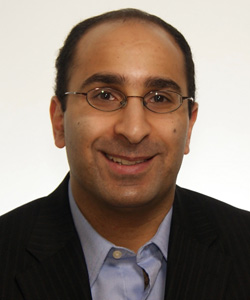Screening for Sleep Apnea in Stroke and TIA Patients using a Portable Sleep Monitor: A Randomized Controlled Trial
Cardiovascular and Stroke Care

Mark Boulos
Work Phone: 416-480-4473
Cell Phone: 416-433-5653
Sunnybrook Health Sciences Centre & University of Toronto
Highlights
TRANSFORMATION: Our project could substantially transform the way healthcare is delivered because it would change the way we manage patients with stroke/TIA. Instead of having patients with stroke/TIA undergo inconvenient, frequently-delayed and costly in-laboratory sleep studies at the discretion of their treating physicians, patients would routinely undergo screening for obstructive sleep apnea (OSA) using a portable sleep monitor (PSM) in the convenience of their homes.
ADOPTABILITY: Given that this work would have the potential to improve patient outcomes while reducing healthcare spending, future studies using this novel approach could examine the role of screening for OSA using home-based PSMs in other patient populations and the general public. In addition, this approach could be easily applied to centres outside of Sunnybrook HSC.
OUTCOMES: In addition to assessing cost-effectiveness, we are also examining the number of patients diagnosed and treated for OSA, blood pressure, sleep-related quality of life, functional status, and daytime sleepiness.
Abstract
Obstructive sleep apnea (OSA), which causes abnormal pauses in breathing during sleep, occurs in the majority of patients with stroke or temporary stroke-like symptoms (also known as “transient ischemic attack” [TIA]). OSA is very important to diagnose after stroke/TIA because it is linked with many undesirable consequences and is treatable. Although OSA is prevalent after stroke/TIA and is linked with numerous negative outcomes, routine testing for OSA does not typically occur in this clinical setting. Questionnaires inaccurately diagnose OSA after stroke; in-laboratory sleep studies, the gold standard for assessing OSA, are limited by low availability, long waiting times, and patient unwillingness to sleep overnight in a sleep laboratory. Fortunately, home-based portable sleep monitors (PSMs) can also accurately diagnose OSA, and these are much more accessible and convenient compared to in-laboratory sleep studies. PSMs are also much cheaper than in-laboratory sleep studies, which involve pricey equipment, an on-site technologist and costly OHIP billings. Although there are so many potential advantages to the use of PSMs to screen for OSA after TIA/stroke, they are not used routinely in Ontario hospitals or clinics.
The main purpose of this study is to determine whether broad screening for OSA using a PSM, compared to standard care (i.e. in-hospital polysomnography), increases the proportion of patients diagnosed and treated for OSA after stroke/TIA. We will also examine functional outcomes, daytime sleepiness, ambulatory blood pressure, and whether this approach is cost-effective when compared to standard care.

